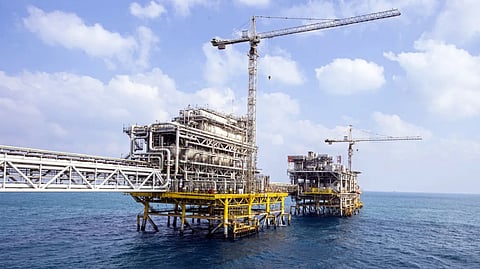

Saudi Arabia is caught between Donald Trump and a hard place, as the US president’s latest oil sanctions on Russia force Riyadh to weigh competing geopolitical and economic priorities.
Washington last week sanctioned Russia's top two oil companies Rosneft and Lukoil, which jointly produce around five per cent of global oil supplies. The US is seeking to squeeze the Kremlin’s revenue to pressure Moscow to return to the negotiating table to end the war in Ukraine.
The move has sent oil prices up five per cent since October 23 to around $66 a barrel on fears that the sanctions and potential retaliation could constrain global oil supplies.
This creates a diplomatic conundrum for Saudi Arabia. The de facto leader of the Organisation of the Petroleum Exporting Countries will need to balance its own strategic goals with its need to maintain the group’s alliance with Russia and other major producers, collectively known as OPEC+.
OPEC+ members will meet on November 2 to decide on their output quota for December.
Reuters reported on Monday that the group is leaning towards a small increase of 137,000 barrels per day, though only a handful of members, including Saudi Arabia, appear to have the capacity to increase production.
OPEC+ has increased its target since April by more than 2.7 million bpd, arguing that resilient global economic activity has boosted demand for oil.
The additions have nevertheless contributed to what looks like a severe excess supply of oil that the International Energy Agency expects to continue throughout this year and next.
Saudi Arabia is likely facing pressure from Russia to stop or even reverse OPEC+ production increases, as adding more oil into the market would exacerbate the glut and further curtail revenue for Moscow, which relies on oil and gas for a quarter of its federal budget.
However, Trump will almost certainly push for the opposite when he meets Saudi Crown Prince Mohammed bin Salman in the White House on November 18, as media reports suggest.
Riyadh has been looking to strengthen its strategic ties with the United States, as was clear during Trump's visit to the kingdom in May.
Indeed, Saudi Arabia’s decision to increase production this year may be, at least in part, driven by Trump's repeated calls for OPEC to increase oil output to lower energy prices.
The US oil sanctions on Russia therefore create a rather complex calculus for the Saudis.
To make matters more challenging, it is unclear what the supply impact of US sanctions on Rosneft and Lukoil will actually be.
The two firms have accounted for more than half of Russia’s 9.2 million bpd produced so far this year and 47 per cent of the country’s seaborne crude oil exports of 3.5 million bpd, according to analytics firm Kpler. Rosneft also exports nearly 900,000 bpd of crude to China via pipeline.
While several major buyers in India and China, the two biggest importers of Russian oil, have suspended purchases since Trump’s announcement to avoid US reprisals, this does not mean Russian production will actually decline in the near term.
Rather, the most likely scenario is that Russian oil will initially accumulate on vessels at sea before being gradually absorbed by smaller Chinese refiners and other buyers willing to use so-called "shadow fleet" tankers to circumvent the sanctions.
Still, Trump's move could potentially lead to the removal of at least 1.5 million bpd of oil from the sanctions-abiding oil market, according to Reuters calculations.
Moreover, the fracturing of the global oil market will likely lead to higher logistics and transportation costs and increased inefficiencies, driving oil prices higher, even if global supplies will not be reduced on an absolute basis.
In short, OPEC – and the Saudis – will need to factor these sanctions into their calculations even though they will likely struggle to forecast the precise impact on supply.
Saudi Arabia's leadership of the OPEC+ alliance that was formed in 2016 may well face its biggest test to date as it tries to navigate the fallout from the US sanctions on Russia.
The kingdom, the world's largest oil exporter, certainly has capacity to increase its output and help Trump keep a lid on crude prices.
Riyadh has already shown this year that it is willing to take a temporary hit from lower oil prices to both increase its market share and, potentially, please the White House. Indeed, even after Trump’s sanctions announcement last week, Brent crude is still down 12 per cent on the year.
But opposing Russia also risks fracturing cohesion within an already shaky OPEC+ alliance, one that has been the bedrock of the kingdom’s successful market management strategy over the past nine years.
Therefore, even if OPEC’s next move is small, the implications for Saudi strategy could be massive.
(Ron Bousso; Editing by Jan Harvey)
